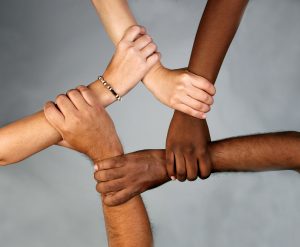9.1 Diversity

What is Diversity?
Diversity is the inclusion of people who identify themselves differently, including but not limited to: race, gender, sexuality, religion or spirituality, and age. Diversity should be a welcomed concept in all parts of life, including the workplace.
Before diving into what it means to have a diverse and inclusive organizational culture, some terms and their definitions need to be discussed.
- Managing Diversity: this means an organization is ensuring that members of diverse groups are valued and treated fairly in all parts of the environment.
- Valuing Diversity: often used to reflect the ways in which organizations show appreciation for diversity among applicants, employees, and customers.
- Inclusion: degree to which employees are accepted and treated fairly by an organization.
- Surface-level Diversity: includes characteristics of individuals that are readily visible to anyone.
- Deep-level Diversity: characteristics that are not observable, like attitude, values, and beliefs.
- Equity: an approach that recognizes that the systemic barriers posed for a particular person will vary; equity recognizes that different people will need different amounts of resources in order to succeed and overcome.
- Belonging: the experience of personal involvement in a system or environment to the point they feel themselves to be an integral part of that system.
Diversity is not just a thing to do, it is a mindset and approach that unites ethical management and high performance. It is an organizational strength, not a mere slogan or form of compliance with the law. Diversity means including talent from a wide demographic spectrum and including all employees in every aspect of the organization.
The Operations Manager & Inclusion
So, how does an Operations Manager create a culture of inclusion? What are some best practices for diversity, equity, inclusion, and belonging?
Create a culture of inclusion with attention to key practices.
-
- Ongoing professional development so that everyone is consistently learning and developing skills linked to inclusion.
- Adapt routines to make inclusion a foundational element in the workplace.
Set clear expectations.
-
- The expectations should be measurable, here are some examples:
- My manager asks my opinion about the work I complete.
- My manager acknowledges my contributions.
- My manager demonstrates concern about my success.
- Conduct thorough evaluations, provide professional development, and integrate learning opportunities at all levels of the organization.
- The expectations should be measurable, here are some examples:
Align the mission to advance equity.
-
- Organizations must abandon one-size-fits-all mindset and tailor services to community members unique conditions and cultural factors.
- Being an inclusive leader, means an adaptive playbook for equity and the support of the board.
Operations Manager Toolkit
“Introducing Workplace Diversity” in Creating a Diverse and Inclusive Organizational Culture by Andrea Bearman is licensed under a Creative Commons Attribution 4.0 International License, except where otherwise noted.


